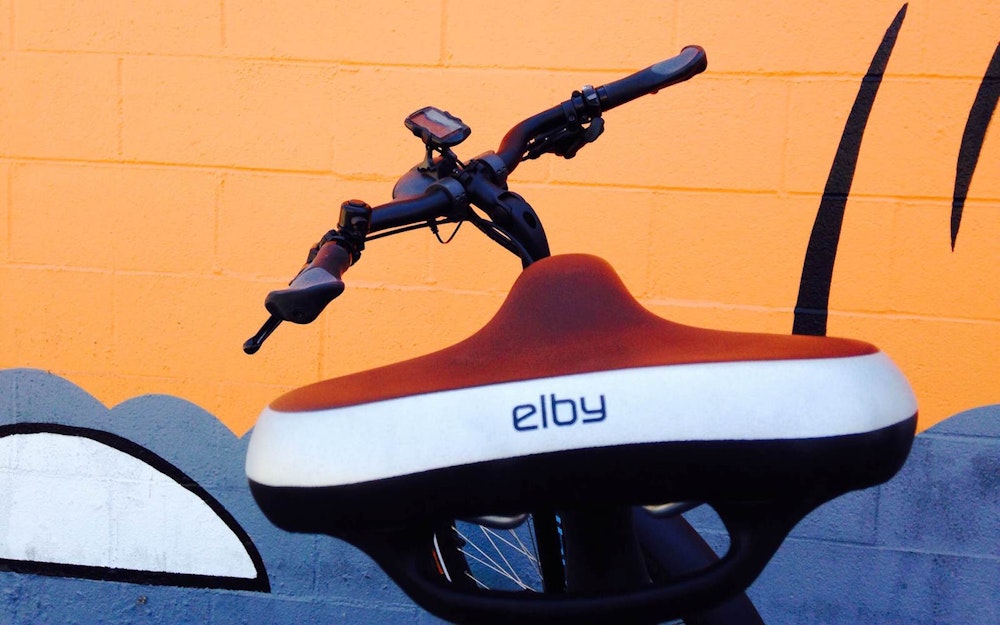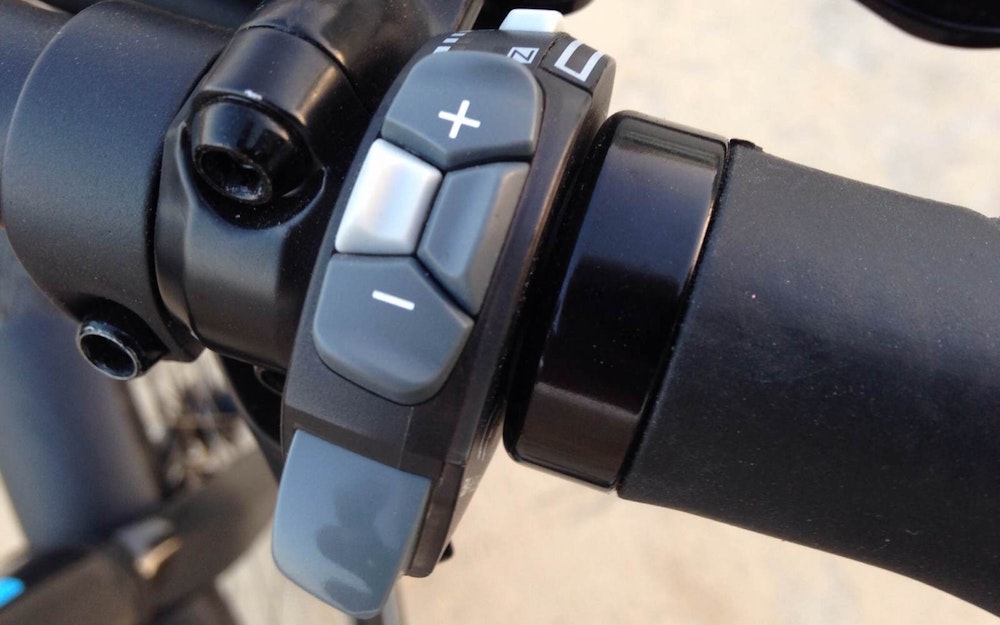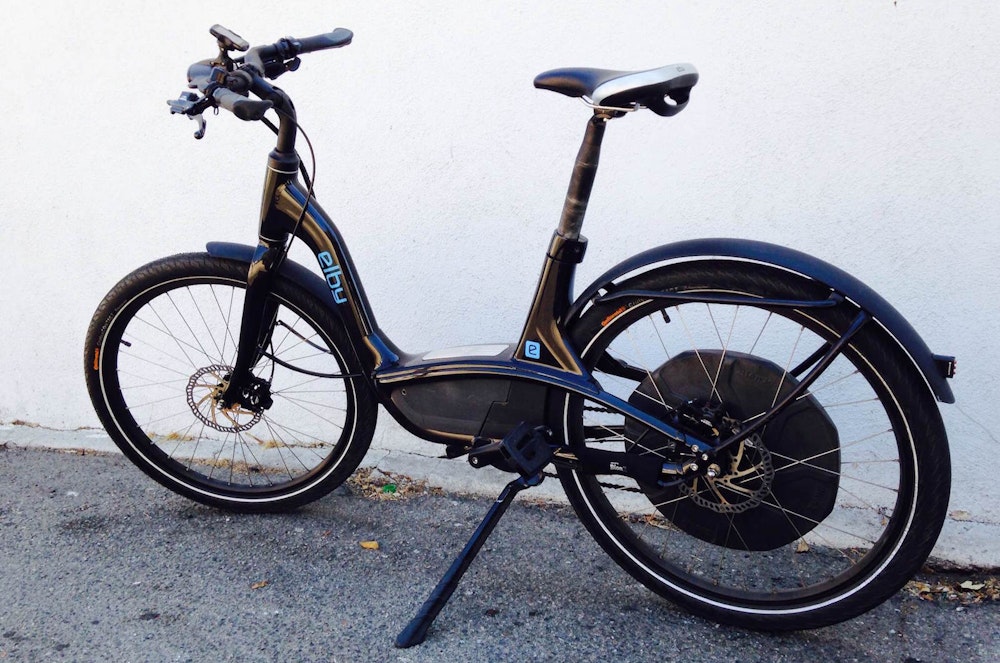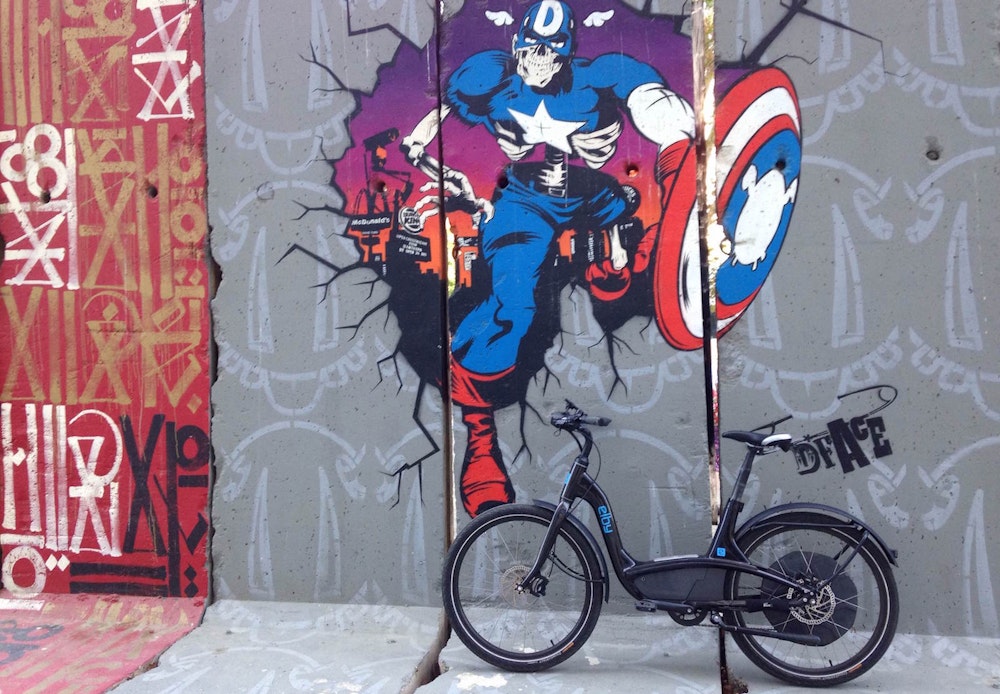I am on the bike path with dusk looming and a guy on a Specialized Tarmac on my wheel. I can hear him breathing. He is working, and not coasting. He has not taken a pull for at least three miles. We are churning into a headwind at 20 miles per hour (32kph).
He’s wearing matching kit and a big backpack — a road rider on his way home from work, I presume. I am wearing jeans and Chuck Taylors. I twist my head and shout into the wind, “Feel free to sit on as much as you want.”
I imagine he is happily glued behind my upright figure, because that’s how I always feel when I can hitch a ride to or from the office behind an e-bike. Only now, I’m the guy with his right thumb on the throttle button.
I’ve ridden to and from work every day for two years now — it’s about 35 miles (56km), round-trip. Almost all of that has been on a road bike, but over the course of two summer months I was able to log about 1,300 miles (2,100km) of commuting on an e-bike, an Elby nine-speed.
This was hardly my first ride on an e-bike. I’ve done a fair amount of riding on the Specialized Turbo and Stromer’s STI, and tried electric models from Yuba, Faraday, Pedego, and others. But this was the first long-term, real-world test I’ve ever done in the category.
Though I have felt for years that e-bikes have the potential to change urban transport, I previously have used them only as toys. Like many other devoted cyclists, I honestly have looked as e-bikes with ambivalence — great for other people, but probably not something that would fit into my life.
But now that I’ve done a solid block of commuting on one, my feelings have evolved. Here’s a summary of my feelings — about the Elby, and riding e-bikes in general — all of it through the lens of a road rider.

IT’S NOT JUST ABOUT SPEED, IT’S ABOUT TIME
At first glance, the Elby sort of references a Dutch bike, but the relaxed visuals belie a bike that handles very well, particularly at speed. It rails turns better than any e-bike I can remember riding (though I suspect that high-performance options like the Stromer and the Turbo might handle similarly if kept at 20 miles per hour, the speed at which the motor on the Elby tops out).
Whenever I’ve ridden an e-bike I’ve gotten used to curious stares and questions, but typically the comments all came from men. With this Elby, I’ve gotten as much interest from women. To wit: My wife, who never has shown any desire to try of the e-bikes I’ve brought home, wanted to ride it. Since I am 6-foot-2 (1.88m) and my wife is 5-foot-4 (1.62m) we rarely can share a bike, but the Elby’s laid-back frame geometry, and a rotating stem, allowed us to swap back and forth with quick adjustments to the saddle and handlebar position.
Now my wife wants an e-bike. Given the price points in the category — the nine-speed Elby I tested retails for $3,700 — the premise of a couple being able to share a single bike seems like a big plus, at least in our household.
So how fast is it? On a road bike, my commute takes between 55 minutes (pedaling hard with favorable wind) to 75 minutes (with bad wind, and/or bad legs). On a typical day, it’s about 68 minutes. On the Elby, my usual commute took me 55 minutes, in street clothes. I frequently rode in jeans, in August in Los Angeles, without getting sweaty. So I saved between 10 to 15 minutes each way.
This is not an insignificant amount of time, but it doesn’t capture the full savings. Since I could now dress for work at home, I no longer had to change (twice) at work, or carry a bigger backpack full of kit and clothes. I no longer had to manage the logistics of charging USB-compatible lights, thanks to the Elby’s integrated light system, which is brighter than the mid-priced lights I use on my road bike. And even that doesn’t capture the full savings — with the e-bike I often decided to tackle a hillier, more direct route on my way home. All in all, it added up to maybe 45 minutes a day saved.
The Elby has a top speed of 20 miles per hour (32kph), which makes it compliant with a California law regulating the use of e-bikes on paths. My local paths here in Los Angeles are increasingly traversed by riders on Stromers, Turbos, and other e-bikes that do 28mph (45kph), but they are not doing so legally, even if they kept their top speed no higher than 20 mph, which they’re not. I have not met any cyclists in the wild who seem to understand the regulations. (Related: I have probably logged 12,000 miles on Los Angeles bike paths and have seen law enforcement maybe 10 times. So enforcement is not realistic.)
Like so many laws, the logic of Assembly Bill 1096 makes sense — sort of. There is a smattering of dedicated commuters I see nearly every day — I call them “Stromer Dads” — weaving through bike and pedestrian traffic as they fly down the paths, and I have a persistent concern that I will come upon one of them wrecked with someone pushing a jog stroller. But one morning I took an ST1 and rode it to work as fast as possible. Even though I slowed around other people and around obstacles, I made it in 44 minutes — faster than a car can make that trip on most days.
That’s quick, but I still didn’t even come close to cracking the top 10 on any of the dozens of popular Strava segments along the way. We are talking about a flat bike path that’s typically full of people walking, running, and riding. All this to say that you can ride like a bonehead on an e-bike just like you can ride like a bonehead on a race bike. The key difference, I suppose, is that a relatively inexperienced rider can do 28mph, or 45kph, on an e-bike.

FINGER ON THE THROTTLE
The Elby has a throttle, which you can engage once you’re moving. I am ambivalent about this little grey button, but the truth is that I used it all the time. For the same reasons I always rode the bike set on maximal assist, I generally engaged the throttle whenever I wasn’t at top speed. Mostly because the bike is more fun at 20mph than 15mph. The idea of coasting at 20mph with my finger on a trigger made me profoundly uncomfortable — as if the act would transform my e-bike into something that is not a bicycle — but friends and neighbors who tried the bike, all of them far more casual cyclists, thought the throttle was fun to play with.
I came to see that the throttle had a practical purpose, too. About a third of my daily commute takes place on the frenetic boulevards of Los Angeles. As die-hard urban riders know, intersections can be tricky on busy city streets. I often wind up at stop signs or red lights with sports cars and delivery trucks stacked behind me, and especially buses, which cross in and out of bike lanes — too many of them piloted by impatient or insensitive drivers who are eager to charge ahead or change lanes or make a right turn in the near future.
I am confident and assertive on a road bike, but even then, getting up to speed and taking the lane, or making a left with a turn signal on a crowded city street, can be stressful. On an e-bike, especially one that has a throttle or accelerates quickly with pedal assist, these moments can be defused with little physical effort, even by inexperienced cyclists.
I’ll also note that the age-old rationale to slowly roll through quiet intersections with four-way stop signs likewise evaporates on an e-bike, because it’s effortless to come to full stop and get back up to speed.
Given that the Elby weighs 55 pounds (25kg) — pretty typical for an e-bike — and accelerates to speed so easily, I had some concerns about braking, but the Tektro disc brakes were surprisingly capable. One time I was barreling at top speed down Pico Boulevard, which lacks a bike lane, and an inattentive driver threw open her car door perhaps 30 feet in front of me. I grabbed a ton of brake with both hands and was able to stop, under control, in just enough time. Still, I wouldn’t be surprised if dooring incidents rise as more people ride e-bikes.
I had similar concerns about flats, too — not because I doubted the 2.2-inch-wide Continental Cruise Contact tires, but because I loathed the idea of removing the rear hub-motor wheel. But on one recent night, when I was commuting long after dark with a dead iPhone and no wrench in my bag, I ran over and detonated a glass bottle on National Boulevard. Nothing happened, and after 1,300 miles I haven’t even had to top off the air in my tires.
E-bikes are heavy, so I’m fortunate I have a garage in which to store the bike and thus didn’t have to lift the bike a ton. I don’t own a hitch rack, which would handle an e-bike with ease, so the one or two times I needed to transport the Elby, I had to wrestle it in the back of my SUV. Those are undoubtedly the hardest physical efforts I had in two months of use.

IT’S NOT ABOUT REPLACING BIKES, IT’S ABOUT REPLACING CARS
From my first ride on one five years ago, I was convinced that e-bikes are bikes: They’re fun to ride, and require pedaling them (presuming you don’t coast with your thumb on the throttle). Just like any other bike, they put you on a journey on which you hear and see the world and somehow clear your mind through the rotation of the pedals.
But after a couple of months on one, I’ve had to face just how unwelcoming road cycling culture can be to people who ride e-bikes. I was called numerous vulgar epithets by spandex-clad roadies as I rolled past them with a smile, and I have been on group rides on which Stromer Dads have been derided, for riding like boneheads, for riding in bike lanes, for riding fast, or simply for riding. The question of how to educate less experienced e-bike riders who barrel through crowds, or on bike paths at 28 mph is real, and hard to answer.
In any case, there is some fence-mending that needs to be done. As with all the tribes in the cycling universe, we need to figure out how to find common ground — which shouldn’t be hard with folks who are united by riding.
Now, after my two-month trial is over, I am still wrestling with my feelings about riding regularly on an e-bike. There is simply no getting over how fast and simple and fun it is to get to work — it’s tough to overstate the ease and practicality of the bikes. But at the same time, I often missed the physical labor of riding a bicycle. I missed suffering up hills and into a headwind. It is a trivial thing to mention, but I missed pulling out my phone and launching Strava — not because I’m looking for trophies or KOMs, but because it’s signifies that a bicycle ride is about to happen.
I think I should — and will — get over it. In an ideal world, I’d love to ride an e-bike a couple of days a week — on days that I have an early morning meeting, or need to work late, or perhaps on Fridays before a big weekend ride.
More generally, I think e-bikes have the potential to be transform how people commute in cities — particularly sprawling cities with good weather and mediocre public transit like Los Angeles. The question about e-bikes isn’t whether they’re a good replacement for conventional bikes — the question is about how easily they could replace a car.

Follow BikeExchange: Email | Facebook | Twitter | Instagram | YouTube | STRAVA





